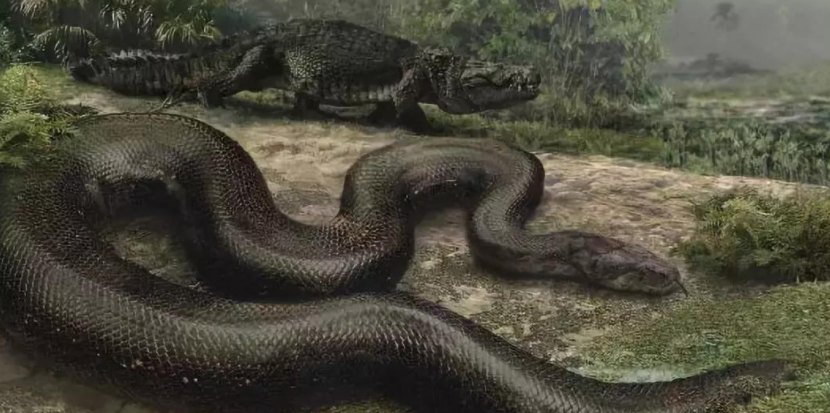Who dominated the earth before the birth of human beings after the extinction of the dinosaurs?
Titan pythons (extinct 58 million years ago) were once considered the largest land carnivores since the extinction of the dinosaurs, reaching up to 15 meters long and weighing about 1,000 kg.

It wasn't until 1986 that a Canadian paleontologist found several strange crocodile skull fossils that spelled out the largest crocodile skull in history, which was about 2 meters long, and biologists finally determined that the skull belonged to the largest giant crocodile of the Cenozoic generation, purussaurus, which was named 100 years ago.
In the late Cretaceous Period, the earth suffered another mass extinction, and the dinosaurs and many reptiles suffered a devastating blow, but the life of the earth was endless, and they experienced many mass extinctions before this, and each destruction was accompanied by the birth of a new overlord.
After the extinction of the dinosaurs, whales dominated the oceans, birds as descendants of dinosaurs still galloped with the continent, but no longer dominated, before mammals fully dominated the earth, crocodiles and large pythons were the last glory of reptiles, and the Prus crocodile was one of the best.
The Prus crocodile lived between 13 million years (the Middle And New Century) as the top predator living in the Amazon, and paleontologists speculate that the Prus crocodile has a body length of 11.5 m and a weight of 5.5 tons, making it the second largest crocodile after the emperor crocodile (a Cretaceous creature that lived 110 million years ago).
The most terrifying thing about the Prussian crocodile is its huge mouth, which is more than 1 m long and covered with sharp teeth, and it feeds on large mammals.
Paleontologists once found a fossil skeleton of a medium-sized sloth covered with 46 tooth bite marks, and the evidence shows that this sloth weighing about 100 kilograms was killed by a juvenile Prussian crocodile that was only 4 meters long.
Scientists reconstructed the skull and muscles of the Prussian crocodile by means of computer modeling through the fossil bones of the Perussian crocodile, and the test result was that the bite force of the Prussian crocodile reached 6900 kg (about 7 tons), which is more than all living things on Earth today.
What is the concept of a bite force of 7 tons? Now the animal with the strongest bite force, the hippopotamus, only has a bite force of about 2 tons, and the bite force of 2 tons can easily bite crocodiles and lions, and the lethality of 7 tons of bite force is unimaginable.
Such a size, bite force combined with "death rolling" can imagine how "spectacular" the Prussian crocodile was when it was preying, and in the Middle Ages, the Prussian crocodile was the absolute ruler of the continent.
As strong as the dinosaurs can not avoid the fate of extinction, the Prussian crocodile is no exception, in the late Middle Ages, the earth gradually cooled, rivers and lakes gradually disappeared, the Prus crocodile habitat was lost, and they lost their living environment to extinction.
What kills a species is usually not its competitors, but changes in the natural environment.
Today's land creatures have almost all evolved in the direction of "miniature version", the giant sloth with a body length of nearly 4 m has gone extinct, leaving only a three-toed sloth that is only 50 cm long, the giant mammoth is extinct, leaving smaller African elephants, Asian elephants, as well as saber-toothed tigers, imperial crocodiles, titan mangs, moa birds, and almost most of the large land animals are on their way to extinction.
Large animals are mostly at the top of the food chain, most severely affected by environmental changes, the Prus crocodile needs to eat about 20 kilograms of meat every day, which requires a large hunting ground, once the lake disappears, its staple food capybaras, sloths will move away, the Prussian crocodile will suffer a devastating blow.
Small animals have a stronger adaptability to the environment, they need less energy, are not picky eaters, reproduce quickly, and are good at adapting to extreme environments.
Don't look at the human beings on the earth today, but when it comes to the prosperity of the population, rodents and insects are even more so, they are all over the world, whether in densely populated cities or in the uninhabited wild, they can live very well.
The world is "survival of the fittest, not survival of the strong", and when an animal is at the top of the food chain and thinks that it is at ease, it may be its most dangerous time, because ease will relax your guard against the environment and lose the ability to adapt to the diverse environment, as the old saying goes: "Born in trouble, die in comfort", which also applies to the biological world.